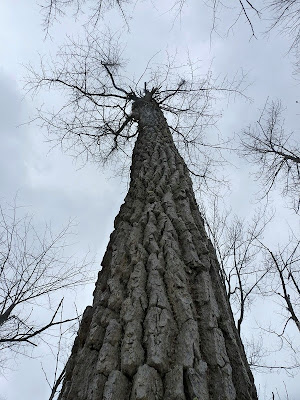Greenfield Center, NY
The snow falls on no two trees alike,
but the forms it assumes are as various
as those which receive it.
They are, as it were, predetermined
by the genius of the tree.
So one divine spirit descends alike on all,
but bears a peculiar fruit in each.
- Thoreau's Journal, 20 Jan 1841.
Today is the Ancient Tree Trek! We gather at Kawing Crow Awareness Center, for a day-long snowshoe walk led by Vince Walsh, woodsman extraordinaire.
New faces, and familiar friends, each of us ready to follow Vince through woods and swamp, to a place where some very very old trees grow.
Last week, down in the valleys, we had a heavy snow, followed by rain. Up here at this higher elevation, it was all snow. So conditions are good for snowshoeing.
First you have to get TO the swamp. Down a steep hill, hanging onto ropes.
 (Kinda tricky with snowshoes on !)
(Kinda tricky with snowshoes on !) And across Swamp One, on a boardwalk Vince built.

The snow, wet and clinging to the trees, is beautiful.
We move into the forest. As the trees flex and move with the slightest puff of wind, down comes a perpetual snowfall. “A second snow” as Thoreau calls it. Big clumps are suddenly splatting down on face or neck – it’s a snowball fight with an invisible (and mischievous) opponent.
We are all happy to be out and about, despite a dark cloudy sky. It’s plenty warm out – almost 40 degrees!
Look down to see snow fleas, marathon dancing on the snow.

Look up to see witch’s broom, growing on a shadbush.

Vince points out other wonders around us. The trail leads past an enormous frilly yellow birch.
At another tree, he talks about burls and other forms of defense that trees mount up against tiny insect and fungal foes.

We come upon tracks and a trough in the snow. An otter has passed this way, heading for the swamp.
Up and over a ridge, to Swamp Two.
In the summer, this swamp is a nesting-place for herons, and the nest-trees are stark against the sky.
We skirt the edges of this swamp, occasionally falling into hollows in the snow. Crossing a snow-covered brook, you hear the water running under there somewhere.
(Don’t want to fall through here!)
The otter’s path loops and crosses ours, though of course the otter himself was here first.
For now all is quiet, save the high questioning notes of goldfinches in the tops of the hemlocks. We are making plenty of noise ourselves.
Vince breaks trail almost the entire way.
I pull out the camera as an excuse to stop and rest, which backfires a little, since everything is getting wet from second-snow.
We come to the beginnings of the creek called Snook Kill.
While catching our breath by the water, we discover that several of us (I won’t mention any names, Bob!) have an affinity for old jokes and awww-ful puns.
(The early stages of dehydration apparently make this worse.)
We are having fun, full of otter-spirit.
Along the way, small glimpses of color catch the eye – how do these delicate things survive the icy blasts of winter?
After a brief lunch break -- yarded up in a hemlock grove, like sandwich-eating deer -- we continue on to Swamp Three.
It is here that the ancient tupelo trees are. They have been tested, and core samples show that they are at least 500 years old -- with newer testing methods indicating closer to 800 years.
Cathedrals were being constructed in medieval Europe -- pyramid temples going up in southern jungles – while these trees rose above the others here in the swamp, and bore their sour fruit.
Our leader pauses before heading in. I think he’s trying to settle us down. These are beings to approach with respect.
I’ve only seen young tupelos, with their drooping-branch profile. These trees however are so old that the lower branches are gone. The tops are bent and broken, but there are still plenty of crinkly branches at the crown.
-Kahlil Gibran

If trees are poems, then these trees are sagas.
Some are hollow at the base, providing shelter for other creatures. All stand taller than most other trees around them, protecting and protected by the very nature of the swamp. But they are not immortal.
We come to a large blow-down, and file past it, paying our last respects as it lay in state.
How to greet these sinewy relatives, who have lived to see so much?
I have no tobacco.
For a moment all I can do is look up, and offer a song.
Then we all notice that the clouds are gone.
Suddenly there’s a bright blue sky overhead, and sunlight is streaming down on these trees. 
The wonder is that we can see these trees
and not wonder more.
- Ralph Waldo Emerson















What a spectacular account, Sue! You've captured it all -- the fun, the variety, the camaraderie, the sense of awe that approaches reverence. That final quote from Emerson is perfect.
ReplyDeleteWhat a wonderful and special outing (!), to the location of such ancient trees!!
ReplyDelete